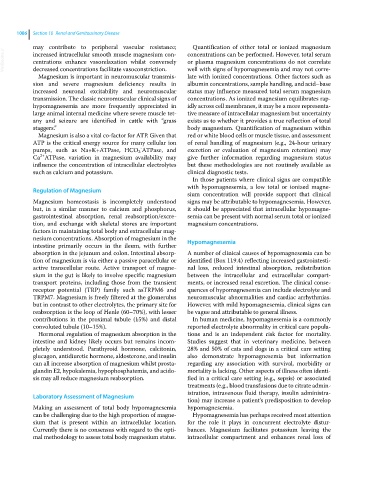Page 1148 - Clinical Small Animal Internal Medicine
P. 1148
1086 Section 10 Renal and Genitourinary Disease
may contribute to peripheral vascular resistance; Quantification of either total or ionized magnesium
VetBooks.ir increased intracellular smooth muscle magnesium con concentrations can be performed. However, total serum
or plasma magnesium concentrations do not correlate
centrations enhance vasorelaxation whilst conversely
decreased concentrations facilitate vasoconstriction.
Magnesium is important in neuromuscular transmis well with signs of hypomagnesemia and may not corre
late with ionized concentrations. Other factors such as
sion and severe magnesium deficiency results in albumin concentrations, sample handling, and acid–base
increased neuronal excitability and neuromuscular status may influence measured total serum magnesium
transmission. The classic neuromuscular clinical signs of concentrations. As ionized magnesium equilibrates rap
hypomagnesemia are more frequently appreciated in idly across cell membranes, it may be a more representa
large animal internal medicine where severe muscle tet tive measure of intracellular magnesium but uncertainty
any and seizure are identified in cattle with “grass exists as to whether it provides a true reflection of total
staggers.” body magnesium. Quantification of magnesium within
Magnesium is also a vital co‐factor for ATP. Given that red or white blood cells or muscle tissue, and assessment
ATP is the critical energy source for many cellular ion of renal handling of magnesium (e.g., 24‐hour urinary
‐
pumps, such as Na+K+ATPase, HCO 3 ATPase, and excretion or evaluation of magnesium retention) may
2+
Ca ATPase, variation in magnesium availability may give further information regarding magnesium status
influence the concentration of intracellular electrolytes but these methodologies are not routinely available as
such as calcium and potassium. clinical diagnostic tests.
In those patients where clinical signs are compatible
with hypomagnesemia, a low total or ionized magne
Regulation of Magnesium
sium concentration will provide support that clinical
Magnesium homeostasis is incompletely understood signs may be attributable to hypomagnesemia. However,
but, in a similar manner to calcium and phosphorus, it should be appreciated that intracellular hypomagne
gastrointestinal absorption, renal reabsorption/excre semia can be present with normal serum total or ionized
tion, and exchange with skeletal stores are important magnesium concentrations.
factors in maintaining total body and extracellular mag
nesium concentrations. Absorption of magnesium in the Hypomagnesemia
intestine primarily occurs in the ileum, with further
absorption in the jejunum and colon. Intestinal absorp A number of clinical causes of hypomagnesemia can be
tion of magnesium is via either a passive paracellular or identified (Box 119.4) reflecting increased gastrointesti
active transcellular route. Active transport of magne nal loss, reduced intestinal absorption, redistribution
sium in the gut is likely to involve specific magnesium between the intracellular and extracellular compart
transport proteins, including those from the transient ments, or increased renal excretion. The clinical conse
receptor potential (TRP) family such asTRPM6 and quences of hypomagnesemia can include electrolyte and
TRPM7. Magnesium is freely filtered at the glomerulus neuromuscular abnormalities and cardiac arrhythmias.
but in contrast to other electrolytes, the primary site for However, with mild hypomagnesemia, clinical signs can
reabsorption is the loop of Henle (60–70%), with lesser be vague and attributable to general illness.
contributions in the proximal tubule (15%) and distal In human medicine, hypomagnesemia is a commonly
convoluted tubule (10–15%). reported electrolyte abnormality in critical care popula
Hormonal regulation of magnesium absorption in the tions and is an independent risk factor for mortality.
intestine and kidney likely occurs but remains incom Studies suggest that in veterinary medicine, between
pletely understood. Parathyroid hormone, calcitonin, 28% and 50% of cats and dogs in a critical care setting
glucagon, antidiuretic hormone, aldosterone, and insulin also demonstrate hypomagnesemia but information
can all increase absorption of magnesium whilst prosta regarding any association with survival, morbidity or
glandin E2, hypokalemia, hypophosphatemia, and acido mortality is lacking. Other aspects of illness often identi
sis may all reduce magnesium reabsorption. fied in a critical care setting (e.g., sepsis) or associated
treatments (e.g., blood transfusions due to citrate admin
istration, intravenous fluid therapy, insulin administra
Laboratory Assessment of Magnesium
tion) may increase a patient’s predisposition to develop
Making an assessment of total body hypomagnesemia hypomagnesemia.
can be challenging due to the high proportion of magne Hypomagnesemia has perhaps received most attention
sium that is present within an intracellular location. for the role it plays in concurrent electrolyte distur
Currently there is no consensus with regard to the opti bances. Magnesium facilitates potassium leaving the
mal methodology to assess total body magnesium status. intracellular compartment and enhances renal loss of

